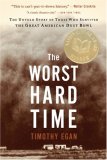Summary | Excerpt | Reviews | Beyond the Book | Readalikes | Genres & Themes | Author Bio
The Untold Story of Those Who Survived the Great American Dust Bowl
by Timothy Egan

Critics' Opinion:
Readers' Opinion:
First Published:
Dec 2005, 320 pages
Paperback:
Sep 2006, 352 pages
 Book Reviewed by:
Book Reviewed by:
BookBrowse Review Team
Buy This Book
And then there was the larger image problem.
Great American Desert. It was Stephen Long, trying to find
something of value in the treeless wilderness, who first used those words in
1820, later printed on maps that guided schooners west. It would stay as
cartographic fact until after the Civil War, when the Great American Desert
became the Great Plains. Zebulon Pike, scouting the southern half of the
Louisiana Purchase in 1806 for Thomas Jefferson, had compared it to the
African Sahara in his report to the president. Jefferson was crushed. He
feared it would take one hundred generations to settle the blank space on the
map. It was a vast empty sea, invariably described as featureless and
frightening by the Americans who traveled through it.
"A desolate waste of uninhabited solitude," wrote Robert Marcy,
after exploring the headwaters of the Red River. Marcy had the same opinion
of the region as did Long, the influential American explorer who followed Pike.
After conducting an extensive survey, Long wrote in 1820 the words that still
make him seem unusually prophetic:
"In regard to this extensive section of the country, I do not hesitate in
giving the opinion that it is almost wholly uninhabitable by a people depending
upon agriculture for their subsistence."
The answer to the syndicate's problem was aggressive
salesmanship. Why, this wasteland could be England or Missouri, if plowed
in the right way. Brochures were distributed in Europe, the American South,
and at major ports of entry to the U.S.: "500,000 acres offered for sale as
farm homes" and cheap, as well, the land selling for thirteen dollars an acre.
Twice a month, agents for the syndicate rounded up five hundred people and
put them on a train from Kansas City for the Texas Panhandle to see for
themselves. The train ride was free.
Speculators who bought from the syndicate turned around and
added to the claims. "Riches in the soil, prosperity in the air, progress
everywhere. An Empire in the making!" was a slogan of W. P. Soash, a real
estate man from Iowa who bought big pieces of the XIT and sold them
off. "Get a farm in Texas while land is cheap — where every man is a landlord!"
To prove the agriculture-worthy potential of the Llano Estacado,
the syndicate set up experimental farms, demonstrating to immigrants how
they could make a go of it on the Texas flatlands. They worked with
government men from the Department of Agriculture. Well, sure, it rained less
than twenty inches a year, which was the accepted threshold for growing a
crop without irrigation, but through the miracle of dry farming a fellow could
turn this land to gold. Put a windmill in, and up comes water for your hogs,
chickens, and garden. And dryland wheat, it didn't need irrigation. Just plant
in the fall, when a little moisture would bring the sprouts up, let it go
dormant
in the winter, and then wait for spring rains to get the crop going again.
Harvest in summer. Any three-toed fool could do it, the agents said. As for
the overturned ground, use the dust for mulch, farmers were advised; it will
hold the ground in place and keep evaporation down. That's what Hardy
Campbell, the apostle of dry farming from Lincoln, Nebraska, preached —
and the government put a stamp on his philosophy through their agriculture
office in the Panhandle. No nester was without Campbell's Soil Culture
Manual, a how-to book with homilies that all but guaranteed prosperity.
What's more, the commotion created by the act of plowing itself would bring
additional rain, causing atmospheric disturbances. Rain follows the plow?
Damn right! The Santa Fe Railroad printed an official-looking progress map,
showing the rain line — twenty inches or more, annually — moving west
about eighteen miles a year with new towns tied to the railroad. With
scientific certainty, steam from the trains was said to cause the skies to
weep.
Copyright © 2005 by Timothy Egan. Reprinted by permission of Houghton Mifflin Company.





The Flower Sisters
by Michelle Collins Anderson
From the new Fannie Flagg of the Ozarks, a richly-woven story of family, forgiveness, and reinvention.

The House on Biscayne Bay
by Chanel Cleeton
As death stalks a gothic mansion in Miami, the lives of two women intertwine as the past and present collide.

The Funeral Cryer by Wenyan Lu
Debut novelist Wenyan Lu brings us this witty yet profound story about one woman's midlife reawakening in contemporary rural China.
Your guide toexceptional books
BookBrowse seeks out and recommends the best in contemporary fiction and nonfiction—books that not only engage and entertain but also deepen our understanding of ourselves and the world around us.